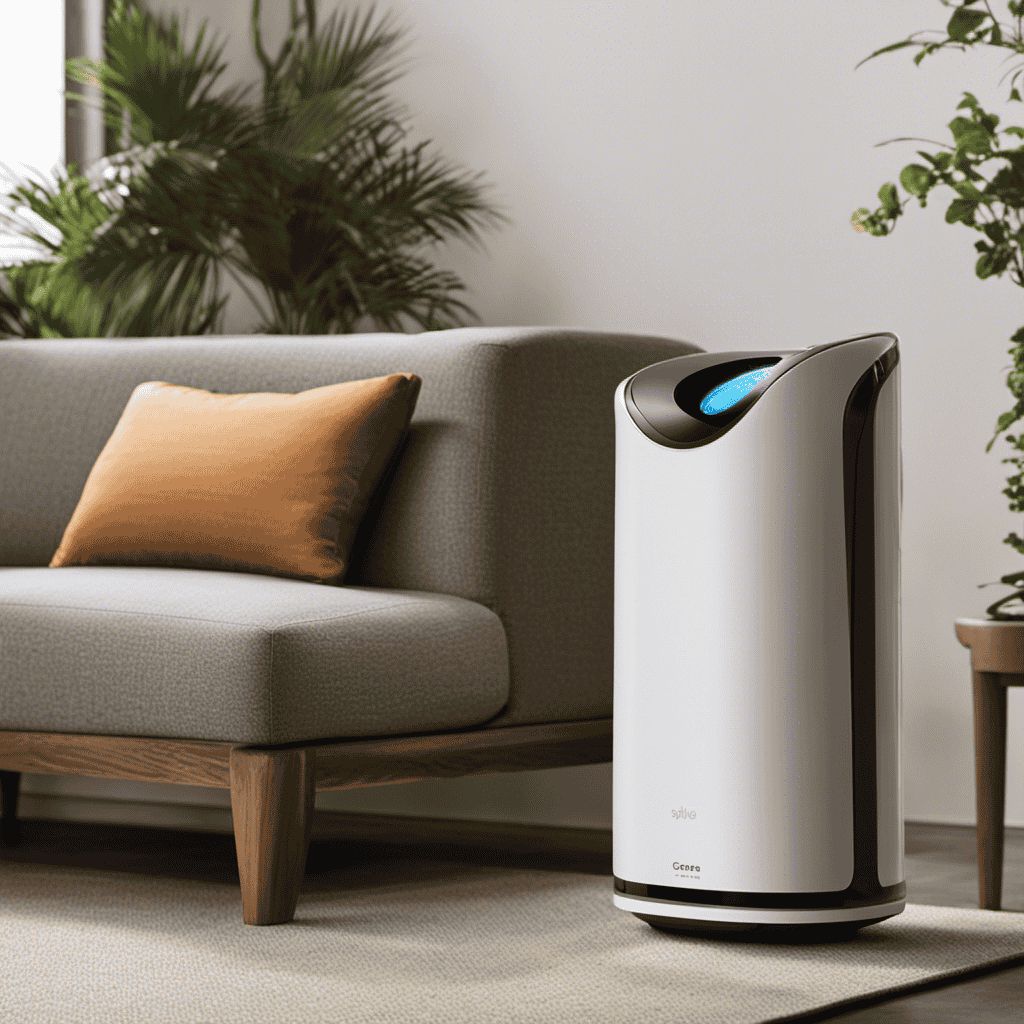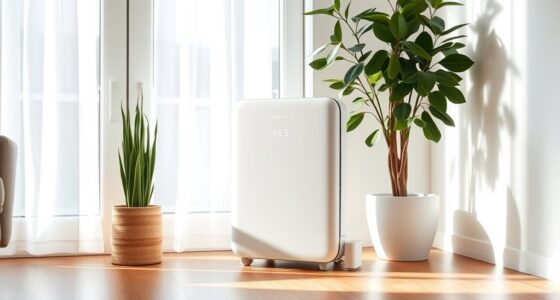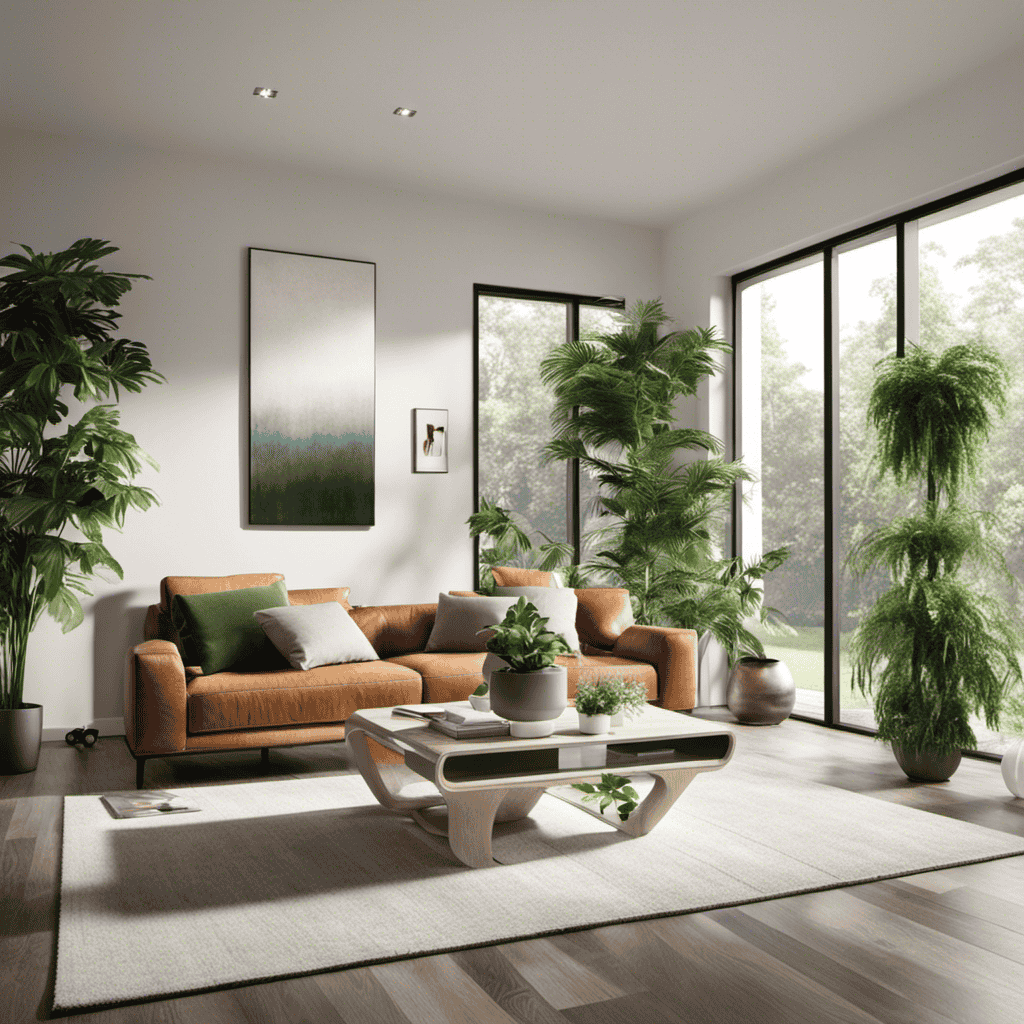I have always faced challenges with the indoor air quality, but utilizing a portable air purifier has significantly improved the situation for me.
In this article, I’ll guide you through the process of selecting, setting up, and operating a portable air purifier.
We’ll cover different types, maintenance tips, and troubleshooting common issues.
With the right purifier, you can improve the air quality in your home and breathe easier.
Let’s dive in and discover how to use a portable air purifier effectively.
Key Takeaways
- Consider the size of the room and specific air quality needs when selecting a portable air purifier
- Different brands offer features that cater to different room sizes and air quality needs
- Types of portable air purifiers include HEPA, activated carbon, and ionizer purifiers
- Set up the purifier in a central location, ensure proper ventilation, and choose appropriate fan speed based on needs and preferences
Selecting the Right Portable Air Purifier
When selecting the right portable air purifier, it’s important to consider the size of the room you plan to use it in. Different portable air purifier brands offer various features that cater to specific room sizes and air quality needs.
Some popular portable air purifier brands include Dyson, Honeywell, and GermGuardian. These brands offer a range of features such as multiple filtration stages, HEPA filters, and activated carbon filters, which effectively remove dust, pollen, pet dander, and odors from the air.
Additionally, some portable air purifiers come with smart features like Wi-Fi connectivity and mobile app control, allowing you to monitor and control the air purifier remotely.
When choosing a portable air purifier, carefully assess the room size and consider the specific features that will best suit your air purification requirements.
Understanding the Different Types of Portable Air Purifiers
There are various types of portable air purifiers available, each with its own unique features. Understanding the different types of portable air purifiers can help you make an informed choice based on your specific needs.
The most common types include HEPA, activated carbon, and ionizer air purifiers. HEPA purifiers are highly effective at removing allergens and particles from the air, but they may not eliminate odors. Activated carbon purifiers excel at removing odors and chemicals, but they may not be as effective at removing particles. Ionizer purifiers release negative ions to neutralize pollutants, but they may produce ozone as a byproduct.
Each type has its benefits and drawbacks, so it’s important to consider your specific requirements before making a purchase.
Now that you understand the different types of purifiers, let’s move on to setting up your portable air purifier.
Setting Up Your Portable Air Purifier
To start setting up your portable air purifier, all you need to do is plug it into a power source. Once you have done that, follow these steps to ensure proper setup:
-
Setting up Filters: Most portable air purifiers come with a pre-installed filter, but it is essential to check and ensure it is properly in place. Some models may require you to remove a protective covering before use.
-
Power Consumption and Energy Efficiency: Before turning on your air purifier, check its power consumption and energy efficiency. Look for an Energy Star certified model that consumes less energy while providing efficient air purification.
-
Placement: Position your air purifier in a central location, away from obstructions like furniture or curtains. This allows for proper air circulation and ensures optimal purification.
-
Ventilation: Ensure that there is sufficient space around the air purifier for proper ventilation. This allows for proper airflow and maximizes the effectiveness of the purifier.
By following these steps, you can effectively set up your portable air purifier and ensure its optimal performance in filtering allergens and pollutants.
Now, let’s move on to discussing the operating modes and settings of your portable air purifier.
Operating Modes and Settings of Your Portable Air Purifier
Now you can adjust the operating modes and settings of your purifier to customize the air purification process.
Let me explain the different operating modes available.
The first mode is the Auto mode, which automatically adjusts the fan speed based on the air quality. This mode is great if you want the purifier to work efficiently without having to constantly adjust the settings.
The second mode is the Sleep mode, which operates at a lower fan speed and with reduced noise, making it ideal for use during nighttime or in a quiet environment.
Lastly, we have the Manual mode, where you can manually adjust the fan speed settings to your preference. Understanding the fan speed settings is essential for controlling the intensity of air purification. The higher the fan speed, the faster the air is purified, but it may also produce more noise. Choose the appropriate fan speed based on your needs and preferences.
Maintaining and Cleaning Your Portable Air Purifier
Make sure you regularly clean and maintain your purifier to ensure optimal performance and longevity. Here are some cleaning techniques and a maintenance schedule to help you keep your portable air purifier in top shape:
-
Dust the exterior: Use a soft cloth or a brush attachment on your vacuum cleaner to remove dust and dirt from the surface of the purifier.
-
Clean the filters: Check the manufacturer’s instructions for guidance on how to remove and clean the filters. Typically, this involves rinsing them with water or using a vacuum cleaner to remove debris.
-
Wipe down the grill: Use a damp cloth to clean the intake and exhaust grills to remove any accumulated dust or particles.
-
Maintain a schedule: Set a reminder to clean the purifier every 1-3 months, depending on the manufacturer’s recommendations.
By following these cleaning techniques and maintaining a regular schedule, you can ensure that your portable air purifier continues to operate at its best.
Now, let’s explore where to place your purifier for maximum efficiency.
Where to Place Your Portable Air Purifier for Maximum Efficiency
When it comes to maximizing the efficiency of your portable air purifier, ideal placement spots and avoiding airflow obstructions are key considerations.
To ensure optimal performance, it is important to place your air purifier in a central location within the room, away from walls and corners.
Additionally, it is crucial to avoid placing the purifier near any objects or furniture that could obstruct the airflow and hinder its ability to effectively clean the air in your space.
Ideal Placement Spots
The best spots for placing a portable air purifier are in bedrooms, living rooms, office spaces, and common areas. Here’s why:
-
Bedrooms: Having an air purifier in your bedroom can improve your sleep quality. It filters out allergens and pollutants that can cause respiratory issues and disturb your sleep. It also helps remove odors and creates a clean and fresh environment.
-
Living rooms: Placing an air purifier in your living room ensures that the air you and your family breathe is clean and healthy. It eliminates dust, pet dander, and other airborne particles, reducing the risk of allergies and respiratory problems.
-
Office spaces: Air purifiers in office spaces promote a healthier work environment. They remove pollutants, such as volatile organic compounds (VOCs) and airborne bacteria. These pollutants can cause headaches, fatigue, and difficulty concentrating.
-
Common areas: If you have a common area or open space in your home or office, placing an air purifier there can help maintain a clean and fresh atmosphere for everyone.
Incorporating regular air purifier maintenance, such as cleaning or replacing filters, can maximize its efficiency. This ensures that it continues to provide you with the many benefits of clean air.
Avoiding Airflow Obstructions?
When using a portable air purifier, it is important to avoid airflow obstructions to ensure optimal performance and efficiency. By avoiding obstructions, you can prevent noise disturbances and maximize the energy efficiency of your device.
To help you understand how to avoid airflow obstructions, I have provided a table below with some common obstructions to watch out for:
| Obstruction | Description | Solution |
|---|---|---|
| Furniture | Placing the air purifier near furniture can block the airflow. | Move the furniture away or find a new placement spot. |
| Curtains | Hanging curtains in front of the unit can impede the airflow. | Keep curtains away from the air purifier or use tie-backs. |
| Walls | Placing the unit too close to walls can restrict the airflow. | Leave some space between the air purifier and walls. |
| Electronics | Keeping the unit near electronics can interfere with its performance. | Keep the air purifier away from electronic devices. |
| Plants | Placing the air purifier near plants can obstruct the airflow. | Relocate the plants or find a new spot for the air purifier. |
Using a Portable Air Purifier in Different Rooms and Spaces
When it comes to achieving optimal air purification in different rooms and spaces, two key factors to consider are the placement of the portable air purifier and adjusting its settings for maximum effectiveness.
The placement of the purifier plays a crucial role in its ability to capture and remove airborne pollutants. By strategically positioning the purifier in areas with high pollutant concentration or where air circulation is limited, you can significantly enhance its performance.
Additionally, adjusting the purifier’s settings, such as fan speed and filtration mode, according to the specific needs of each room or space can further optimize its effectiveness in providing clean and healthy air.
Optimal Purifier Placement
To ensure the best air purification, make sure you place the portable air purifier in an area with good air circulation. Here are four key points to consider for optimal purifier placement:
-
Avoid Obstacles: Place the purifier away from any obstacles such as furniture, curtains, or walls that may obstruct the airflow. This will allow the purifier to effectively capture and filter the air in the room.
-
Central Location: Position the purifier in a central location within the room to ensure even distribution of purified air. This will help to maximize the purifier’s coverage and effectiveness.
-
Elevated Position: If possible, place the purifier on an elevated surface like a table or a shelf. This will help to improve the purifier’s intake of air by minimizing the interference caused by dust and pollutants on the floor.
-
Open Space: Ensure that the area around the purifier is free from clutter and has enough open space for proper airflow. This will enable the purifier to efficiently draw in the contaminated air and release purified air back into the room.
By following these placement guidelines, you can optimize the airflow and enhance the overall effectiveness of your portable air purifier.
Now, let’s move on to the next section where we will discuss adjusting settings for maximum effectiveness.
Adjusting Settings for Effectiveness
Make sure you adjust the settings on your purifier to maximize its effectiveness.
One important setting to consider is the fan speed. Adjusting the fan speed can greatly impact the purifier’s ability to clean the air in your space.
If you need a quick clean-up, setting the fan speed to high will provide maximum airflow and filtration. However, if you want a more quiet operation, setting the fan speed to low will still effectively clean the air while minimizing noise.
It’s also worth noting that adjusting the fan speed can also help conserve energy and prolong the life of your purifier. Regularly checking and adjusting the fan speed as needed is an important part of air purifier maintenance.
Tips for Improving Indoor Air Quality With a Portable Air Purifier
You can easily improve indoor air quality by using a portable air purifier. Here are four tips to help you achieve better air quality and enjoy a healthier living environment:
-
Filter out allergens: Portable air purifiers are equipped with filters that can capture and remove common allergens such as dust mites, pollen, and pet dander. This can greatly reduce the presence of these allergens in your home, leading to a reduction in allergy symptoms and better sleep quality.
-
Eliminate odors: Portable air purifiers often have activated carbon filters that can absorb and neutralize unpleasant odors from cooking, pets, or smoke. By removing these odors, you can create a more pleasant and fresh-smelling indoor environment.
-
Reduce airborne pollutants: Air purifiers can effectively remove airborne pollutants like volatile organic compounds (VOCs), mold spores, and bacteria. By reducing these pollutants, you can breathe cleaner air and promote better respiratory health, which can contribute to improved sleep quality.
-
Create a peaceful atmosphere: Some portable air purifiers come with built-in features like white noise settings or night mode, which can help create a calm and soothing atmosphere in your bedroom. This can aid in relaxation and promote better sleep.
Understanding the Filter Replacement Process for Your Portable Air Purifier
Now that we have discussed how to improve indoor air quality with a portable air purifier, let’s delve into understanding the filter replacement process for your device.
Regular filter replacement is crucial for maintaining optimal performance and ensuring clean air in your space.
To begin, it is essential to follow the manufacturer’s recommendations for filter replacement scheduling. Different models may have varying timeframes for when filters should be replaced. It is important to adhere to these guidelines to ensure the air purifier operates effectively.
When it comes to disposing of the used filters, proper filter disposal is vital to prevent any contamination or environmental harm. Check with your local waste management guidelines to determine the correct method for disposing of the filters. Some filters may be recyclable, while others may require special handling.
Troubleshooting Common Issues With Portable Air Purifiers
To troubleshoot common issues with your portable air purifier, start by checking the power source and ensuring that the device is properly plugged in. Here are some steps you can take to optimize performance and efficiency:
-
Clean the filters regularly: Over time, dust and particles can accumulate on the filters, reducing their effectiveness. Remove the filters and clean them according to the manufacturer’s instructions.
-
Check for obstructions: Make sure there are no obstructions in the air intake or outlet vents. Blocked vents can restrict airflow and hinder the purifier’s performance.
-
Reset the device: If you’re experiencing issues with the air purifier, try resetting it by turning it off and unplugging it for a few minutes before plugging it back in and turning it on again.
-
Consult the user manual: If you’re still facing issues, refer to the user manual for troubleshooting tips specific to your model.
By following these steps, you can troubleshoot common issues and ensure your portable air purifier is running at its best.
Now, let’s explore some additional features and accessories for your portable air purifier.
Additional Features and Accessories for Your Portable Air Purifier
When it comes to choosing a portable air purifier, there are several additional features and accessories that can enhance its performance and convenience.
One key feature to consider is enhanced filtration options, which can include multiple filter layers or specialized filters for specific pollutants.
Another useful feature is a convenient remote control, allowing you to adjust settings and monitor air quality from a distance.
Additionally, it is important to ensure that your portable air purifier is compatible with different power sources and can easily be moved around to different areas of your home or office.
Enhanced Filtration Options
There’s an upgraded air purifier model with enhanced filtration options available. As a user, I find these new features to be incredibly beneficial for portable air purifier maintenance and overall air quality improvement.
Here are the key enhancements:
-
HEPA Filtration: The upgraded model now comes with a High-Efficiency Particulate Air (HEPA) filter, capable of capturing ultrafine particles as small as 0.3 microns, including dust, pollen, pet dander, and mold spores.
-
Activated Carbon Filter: This new addition helps to eliminate unpleasant odors, smoke, and harmful gases from the air, providing a fresher and cleaner environment.
-
UV-C Light Technology: The air purifier is equipped with UV-C light, which targets and neutralizes airborne germs, bacteria, and viruses, ensuring a healthier breathing space.
-
Smart Sensor Technology: With advanced sensors, the purifier can detect changes in air quality and automatically adjust its filtration speed to maintain optimal purification levels.
The benefits of using a portable air purifier with enhanced filtration options are clear. It allows for better air quality, reduced allergens, and a healthier living environment.
Convenient Remote Control
With the convenient remote control, you can easily adjust the settings of the upgraded model to suit your preferences.
This portable air purifier comes equipped with advanced remote control features that enhance the user experience.
The remote control allows you to effortlessly control various functions, such as adjusting fan speed, setting timer operations, and toggling between different modes.
The benefits of using a remote control are numerous. Firstly, it provides ease of use and convenience, allowing you to control the air purifier from a distance without having to physically interact with the device.
Secondly, it enables you to customize your air purification experience according to your specific needs and preferences.
Lastly, the remote control features ensure that you can effortlessly optimize the performance of the air purifier, resulting in cleaner and fresher air in your surroundings.
Portable Air Purifier Compatibility
The upgraded model is compatible with various devices, allowing you to easily control and optimize its performance. Here are four key benefits of the portable air purifier’s compatibility:
-
Seamless Integration: The portable air purifier can be connected to your smartphone or tablet via Bluetooth or Wi-Fi, providing a seamless integration with your existing smart home devices.
-
Remote Monitoring and Control: With the compatible app, you can remotely monitor and control the air purifier from anywhere, ensuring that your indoor air quality is always at its best.
-
Automated Optimization: The app also enables the air purifier to automatically adjust its settings based on real-time air quality data, ensuring optimal purification levels at all times.
-
Effortless Maintenance: The app sends you regular maintenance reminders, such as filter replacements, ensuring that your air purifier operates at its peak performance and efficiency.
With its compatibility with various devices, the portable air purifier not only simplifies your life but also provides you with a healthier and cleaner indoor environment.
Frequently Asked Questions
Can a Portable Air Purifier Remove All Types of Pollutants From the Air?
Yes, a portable air purifier can remove various types of pollutants from the air. Regular air purifier maintenance ensures optimal performance. The benefits of using an air purifier include cleaner air, improved respiratory health, and reduced allergy symptoms.
Are Portable Air Purifiers Effective in Reducing Allergies and Asthma Symptoms?
Portable air purifiers are effective in reducing allergies and asthma symptoms. Regular maintenance of a portable air purifier ensures optimal performance. Using a portable air purifier provides numerous benefits, such as improved air quality and a healthier living environment.
How Often Should I Clean the Filters in My Portable Air Purifier?
I clean the filters in my portable air purifier regularly to ensure its effectiveness. It is recommended to clean the filters every 3-6 months, or as specified by the manufacturer. Proper maintenance is crucial for optimal performance.
Can I Run a Portable Air Purifier All Day and Night?
Yes, you can run a portable air purifier all day and night. Running the air purifier continuously helps maintain clean air quality, while using it at night can provide the added benefit of improving sleep by reducing allergens and pollutants.
What Is the Recommended Room Size for a Portable Air Purifier to Be Effective?
The recommended room size for optimal air purifier effectiveness depends on the model and its Clean Air Delivery Rate (CADR). A general rule is that a portable air purifier can effectively clean the air in a room up to its recommended room size, providing cleaner and healthier indoor air.
Conclusion
In conclusion, using a portable air purifier has many benefits for improving indoor air quality. It is important to select the right purifier for your needs and understand the different types available.
Setting up and operating the purifier correctly is essential, as well as regularly maintaining and cleaning it. One interesting statistic to note is that according to the Environmental Protection Agency, indoor air can be two to five times more polluted than outdoor air.
Therefore, investing in a portable air purifier can greatly contribute to creating a healthier living environment.










